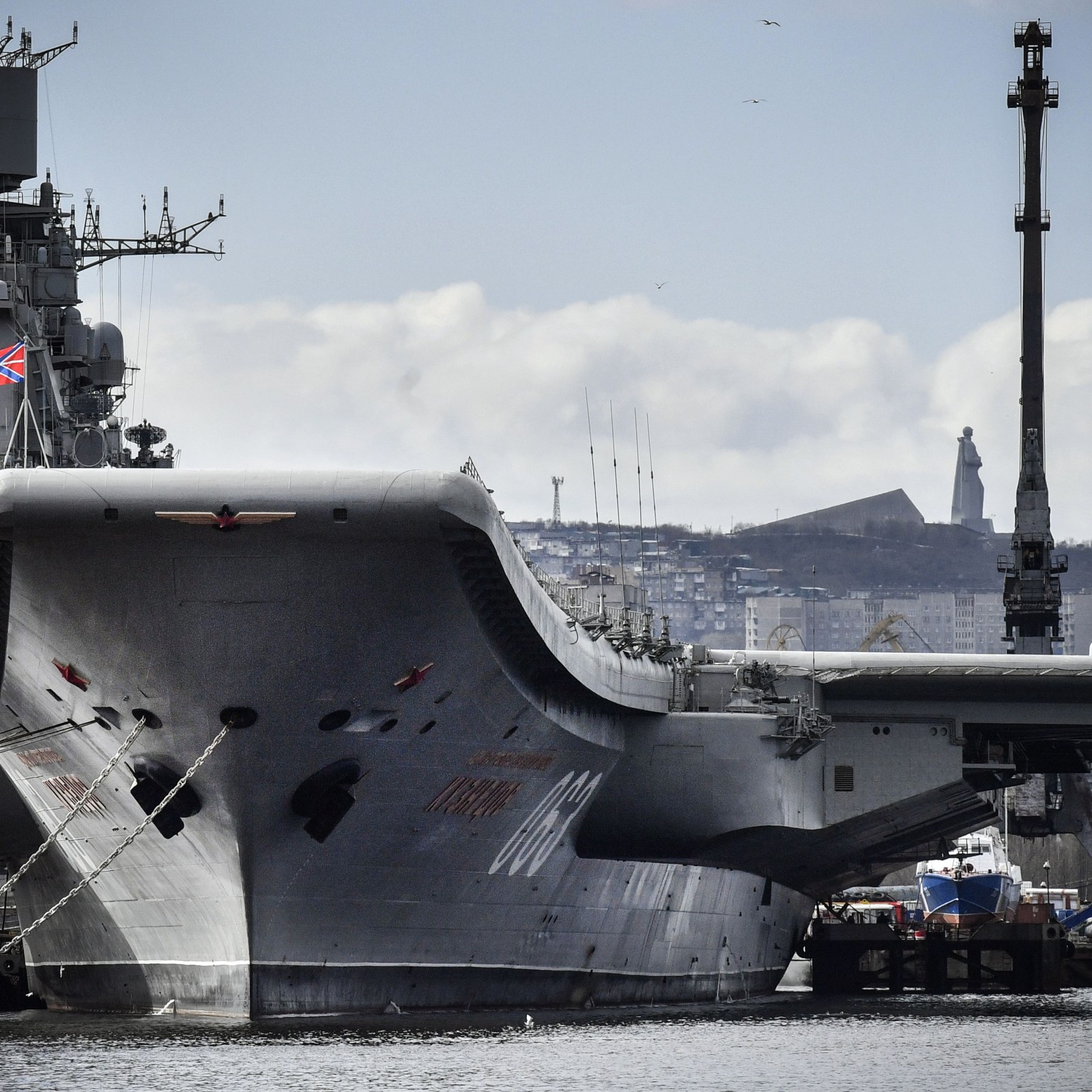Russian Carrier Aircraft - Admiral Flota Sovetskogo Soyuza Kuznetsov (Russian: Admiralota Sovetskogo Souza Kuznetsov, Roman: Admiral Flota Sovetskogo Soyuza Kuznetsov or "Admiral Flota Sovetskogo Soyuza Kuznetsov", original class name) is a Russian heavy aircraft class cruiser.
As the flagship of the Russian fleet. Built by the Black Sea Shipyard, the sole manufacturer of Soviet aircraft carriers, in Mykolaiv, Ukraine, she was launched in 1985 and entered full service with the Russian Navy in 1995. Original ship name: Riga; she was launched as the Leonid Brezhnev, began sea trials as the Tbilisi, and was eventually named Flota Sovetskogo Soyuz Admiral Kuznetsov after Admiral of the Soviet Union Fleet Nikolai Gerasimovich Kuznetsov.
Russian Carrier Aircraft

She was originally assigned to the Soviet Navy and was to be the flagship of the two-ship Admiral Kuznetsov class. However, her sister ship Varyag was still unfinished when the Soviet Union collapsed in 1991.
Kiev & Kuznetsov
The ship has been decommissioned since 2018 and is on wheels for repairs. The repair process is hampered by accidents, waste of money and other malfunctions.
In October 2018, the vessel was towed to Sevmorput Shipyard No. 35 after the buoy PD-50 sank in Kola Bay (Murmansk), killing one worker.
In another accident in December 2019, a large fire killed at least one worker and injured another.
In June 2022, the ship was transferred to the waters of the 35th ship repair factory in Murmansk.
Russia Plans To Build A Nuke Powered Aircraft Carrier To Replace Its Coal Powered Rust Bucket
. It is estimated that the ship will be returned to the Russian Navy in 2024 after the repairs are completed.
The design of the Admiral Kuznetsov class presents a mission distinct from that of the US Navy's carriers. The Tjazholiy Avianesusky Cruiser (TAVKR), the term used by its builders to describe the Russian ships - "heavy aircraft carrier" - is designed to support and intercept Russian strategic missile submarines, surface ships and naval missile aircraft. Navy.
Admiral Kuznetsov's main aircraft is the multipurpose Sukhoi Su-33. It can perform air superiority, fleet destruction and air support missions, and can also be used for direct fire amphibious assault, reconnaissance and sea mine laying.

The cargo ship also houses Kamov Ka-27 and Kamov Ka-27C helicopters for anti-submarine warfare, search and rescue and small transport.
Development] New Ai Aircraft Carriers
Admiral Kuznetsov has a launch pad on the bow for launching fixed-wing aircraft. When flying in an airplane, the airplanes move towards and above the ski jumper. This causes the aircraft to leave the deck at a much greater angle and height than a flat-deck aircraft carrier with catapults. Ski jumping is less demanding on the pilot's body because the acceleration is less, but the speed is only 120–140 km/h (75–87 mph) and requires a non-stall aircraft design. that speed.
The "cruiser" role was aided by the addition of 12 long-range P-700 Granit cruise missiles by Admiral Kuznetsov (NATO reporting name: Crash), which led to the ship being dubbed Russia's "heavy aircraft-". carried by a missile cruiser.
Unlike gas turbine or nuclear-powered ships in Western navies, Admiral Kuznetsov is a conventionally powered ship that uses fuel oil as fuel, often leading to a trail of heavy black smoke visible in the distance. Russian navy officials said improper heating of the fuel oil before igniting the combustion chamber could be a trace of heavy smoke associated with the ship.
Admiral Kuznetsov's designation as an aircraft carrier is crucial to the Montreal Convention, as it allows the ship to pass through the Turkish Straits. The convention prohibits countries from allowing aircraft carriers over 15,000 tons to pass through the strait. Since the ship was built in the Ukrainian SSR, Admiral Kuznetsov would have been stuck in the Black Sea if Turkey had not allowed passage to the Mediterranean Sea.
Fire Breaks Out Aboard Only Russian Aircraft Carrier, No Reports Of Injuries
However, the Convention does not restrict the movement of capital ships operated by the Black Sea Powers. Turkey allowed Admiral Kuznetsov to pass through the strait, and no signatory to the Montreal Convention formally protested her classification as an aircraft carrier.
Admiral Kuznetsov sails in waters south of Italy with the USS Dejo, foreground, left side, December 1991.
The ship "Admiral Flota Sovetskogo Soyuz Kuznetsov", built at the Chernomorsky shipyard in Mykolaiv, part of the Ukrainian SSR (USSR), was commissioned in 1985, and fully operational in 1995. An official ceremony of the start of construction was held. September 1, 1982; In fact, it was founded in 1983. The ship was first named Riga, renamed Leonid Brezhnev, and then Tbilisi. Finally, on October 4, 1990.

After the attempted Soviet coup in 1991, Ukrainian President Leonid Kravchuk sent a telegram to the ship's commander, Viktor Yarygin, stating that Admiral Kuznetsov was owned by the Ukrainians and that the ship should remain in Sevastopol until Ukraine left. decision on his fate. Yuri Ustimko, the deputy commander of the Northern Fleet, rushed from the Arctic to stop the Ukrainian government and ordered Admiral Kuznetsov to sail to Vidyaevo so that the ship would remain in the Soviet fleet.
Russian Aircraft Carrier
From 23 December 1995 to 22 March 1996, Admiral Kuznetsov conducted his first 90-day Mediterranean deployment with 13 Su-33s, 2 Su-25 UTGs and 11 helicopters.
The deployment of the flagship of the Russian fleet was undertaken in October 1696 on the occasion of marking the 300th anniversary of the founding of the Russian Navy. The deployment was to allow the frigate, destroyer and tanker escorted by the carrier to adapt to the Mediterranean climate. and must maintain regular flights until 21:00 each day, as the Barts Sea receives about an hour of sunlight at this time of year.
The ship was laid up at the Northern Fleet shipyard in 1997 after repairs were suspended due to lack of funding. The refit was completed in July 1998 and the ship returned to active service with the Northern Fleet on 3 November 1998.
Admiral Kuznetsov remained in port for two years before preparing for another Mediterranean deployment scheduled for the winter of 2000-2001. This deployment was canceled due to the explosion and sinking of the Kursk nuclear submarine. Admiral Kuznetsov participated in rescue and rescue operations in Kursk in late 2000. Plans for further operations have been delayed or cancelled. In late 2003 and early 2004, Admiral Kuznetsov went to sea for inspections and sea trials. In October 2004, the ship participated in naval exercises of the Russian Navy in the Atlantic Ocean.
Supercarrier Skin // Russian Navy Admiral Kuznetsov Modern Refit Livery
On 27 September 2006, it was announced that Admiral Kuznetsov would return to Northern Fleet service later in the year following a series of upgrades to correct some technical issues. Admiral Vladimir Masorin, Commander-in-Chief of the Russian Navy, also said that the Su-33 fighter jets assigned to him would return after individual maintenance and repair.
On 11 December 2007, Admiral Kuznetsov passed Norwegian oil platforms in the North Sea, 60 nautical miles (110 km) from Berg, Norway.
Su-33 fighters and Kamov helicopters were launched from Admiral Kuznetsov while in international waters; Due to the danger of a collision between a Norwegian helicopter and a Russian aircraft, the maintenance of the drilling helicopter has been suspended. Admiral Kuznetsov later participated in an exercise in the Mediterranean Sea, where she conducted three tactical training missions with live and simulated air-to-surface missile launches alongside 11 other Russian surface ships and 47 aircraft.

Admiral Kuznetsov and his entourage returned to Severomorsk on February 3, 2008. After maintenance, she returned to sea on 11 October 2008 for the Stabilization 2008 strategic exercises in the Barts Sea. On October 12, 2008, Russian President Dmitry Medvedev visited the ship during training.
Russia's Only Aircraft Carrier Damaged While Under Repair As Floating Dry Dock Sinks
On December 5, 2008, the carrier and several other ships sailed from Severomorsk for combat exercises in the Atlantic Ocean, including joint exercises with the Russian Black Sea Fleet and visits to several Mediterranean ports.
On January 7, 2009, a small fire broke out on the ship Admiral Kuznetsov during a visit to the shores of Turkey. One crew member died from carbon monoxide poisoning in a fire caused by a short circuit.
On 16 February 2009, it was refueling off the southern coast of Ireland when, along with other Russian naval vessels, it suffered a major oil spill.
Admiral Kuznetsov returned to Severomorsk on 2 March 2009 and left drydock in September 2010 after scheduled repairs and preparation for a training mission in the Barts Sea.
Ready For Anything': Us Aircraft Carrier Crew Training For War With Russia But Aims To Deter Threats
Admiral Kuznetsov, in the shadow of the British destroyer HMS York off the coast of Great Britain on his way to cruise the Mediterranean, December 2011.
Admiral Kuznetsov will begin deployment in the Atlantic and Mediterranean seas in December 2011, announced the General Staff of the Russian Navy. In November 2011, it was announced that Admiral Kuznetsov would lead a squadron at the Russian Navy facility in Tartus.
A representative of the Russian Navy said through the newspaper "Izvestia" that "there will be no calls for Russian ships in Tartus."

Russian aircraft carrier killer, russian navy aircraft carrier, russian aircraft carrier smoke, russian future aircraft carrier, russian aircraft carrier, russian aircraft carrier varyag, russian aircraft carrier news, russian aircraft carrier plans, russian biggest aircraft carrier, russian flying aircraft carrier, russian aircraft carrier ww2, russian new aircraft carrier
0 Comments